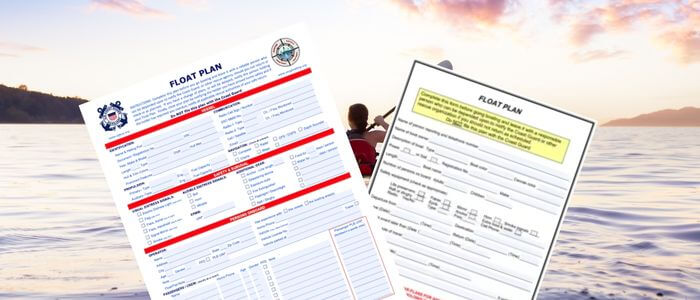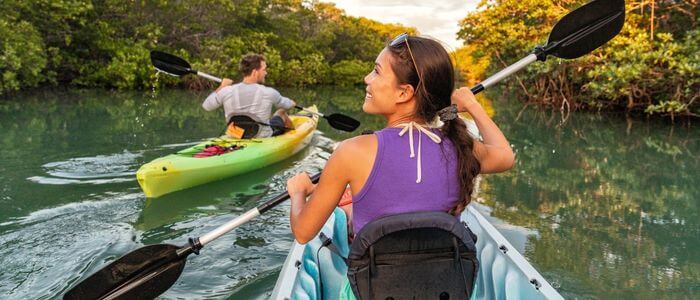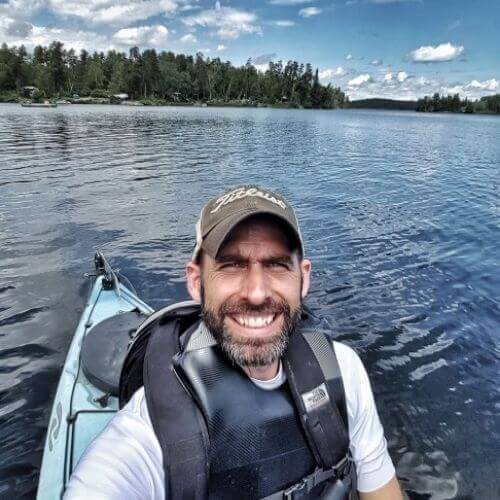
Because kayaking is a pleasant and enjoyable way to spend time outside, one of the best things about kayaking is that you can explore amazing sights, like calm lakes and rivers, spectacular sea sandy beaches, and unrecognized shorelines. But while you’re planning to explore the shorelines and lakes, keep your safety your top priority.
Safety in a kayak is very important before you go out on the water. No matter how nice the weather or calm the water is, kayakers should pay attention to safety and their skills. This article is about the kayak safety tips you should know before starting your kayaking adventure.

Following are some safety tips for a kayaking adventure.
When you first start kayaking, it’s best to do it with a team. Even if you know how to kayak, you can get into danger if you go by yourself because weather and water conditions can change quickly.
Heavy rain can turn a calm river into dangerous waters, and changes in the direction and speed of winds can make it hard to paddle and even cause your kayak to flip over. If something dangerous does happen, it’s best to have people you can depend on to safeguard you.
If you are a beginner unable to join any kayaking team, take a friend with you who knows how to kayak. You can safely learn how to kayak and pick up tips from a friend who has done it before.
Like boating, surfing, and other water sports, kayaking can put a person’s health and safety at risk, especially if they don’t care to stay safe. However, as these risks are there, you can still have a great time in your kayak. Just ensure you have some basic safety equipment.
Most importantly, you should pay special attention to the weather and water temperature. It’s highly recommended to be ready for weather changes and the chances of your boat capsizing. Before heading out in your kayak, you should look at things like the weather and waves.
Proper planning and checking the weather predictions can help you avoid being surprised when the weather changes quickly. Even if you’re going on a multi-day trip or just a short paddle in the midday, knowing the current weather conditions can help you plan to stay safe.
You should inform someone who is outside the waters about your paddling plans. Make sure you tell someone your route, where you’re heading, what you will be doing, how long you think you’ll disappear, and how many people will be with you. Then be sure to follow your plan. If you make a small change to your plan, it’s best to tell someone.
Even though we try not to assume negatively, it can be rather stressful if you realize that you must be rescued. So, if you give the correct information to someone, it will be much easy for rescue teams to find you.
Your floating plan should include important information about your trip, such as:
While preparing to explore the waters, you should also watch for potential hazards. When kayaking in a new area, ask the locals about flows, the condition of the coastline, and the weather. Keep your eyes open for other people on the water.
Bigger boats can move at high speeds and are a big threat to kayakers because they can’t always see kayakers.
If you are alert about the things that could be dangerous, you can handle them and get into having fun on your adventure.
Remember the safety rules for kayaking, like playing as a group and carrying the right gear. This will make things better for you to have more fun on the water since you’ll know you’re prepared for any risk or emergency.
When getting ready for a kayaking trip, it’s important to wear clothes suitable for the weather. Remember that you have to dress for both the weather and the water.
If you’re heading to stay on the water for hours, it’s important to protect your skin from UV rays. Always apply sunscreen to your skin that blocks UV rays well before kayaking. If you’re going to stay on the water for more than half an hour, you should wear a sun hat and a long-sleeved shirt.
When there is water everywhere, it is important to be careful about hypothermia. So you need to know if the water is hot or cold and dress accordingly. If the water temperature where you want to go kayaking is below 70 °F, it is recommended to put on a wet suit or dry suit that will keep you warm and comfortable.
You should choose a perfect location to paddle. The perfect location to kayak is where there is prevention from wind and waves, a smooth surface area for starting and landing, more than one spot to get out of the water, and very few other boats.
It’s best to search for calm lakes, ponds, and rivers that don’t have much load or hazard. Choosing a calm and less loaded place for kayaking means you can kayak in a calm and peaceful environment, with no risk of colliding with big boats or winds and high magnitude waves.
Plan on paddling in open water or going further from shore. You should take a sea kayaking course, which will teach essential open-water lifeguard skills to ensure your safety and the safety of your paddling partners.
Make sure that you or someone else on your trip knows how to help someone hurt. With a basic knowledge of first aid, a situation that could get worse can be easily fixed. If you schedule to go on a bunch of journeys in a short period, it might be a good idea to take the first aid course. It will teach you not to worry in certain situations and what to do in case of emergencies.
You will notice that your skills and confidence will get better the more you use your kayak. If you want to go on a trip with others, ensure you have a better skill level than others. So, if you want to go on a long trip, take a few shorter test rides first. It will certainly polish your kayaking skills. Using the equipment in your test ride that you plan to bring for a long trip can help you determine how heavy your kayak will be and make your trip more confident.
Knowing the kayaking rules and laws in the area where you plan to kayak is very important. Generally, each region has some particular rules and laws to control water traffic. So it would be best to educate yourself about the navigation rules and laws applied in the area where you want to kayak. The Navigation Rules are similar to the rules for driving on a highway. They develop a secure way to navigate and avoid collisions. Avoiding an accident and keeping yourself and many others safe on the water requires familiarity with these rules.
Swimming is an essential skill for kayaking from a safety point of view. If you are planning a water adventure such as kayaking or paddle boarding, you should think about what would happen if you fell off a kayak or boat. You must know how to stay above water, float, and swim at least a few hundred meters. So, if you need to learn how to swim, you should take some swimming classes and start practicing in a pool with trainees before kayaking.
Avoid drinking means you shouldn’t drink alcohol before or while driving a kayak or other boats. If you are in a boat while drunk or intoxicated, the Coast Guard or local police will arrest you and take you to get charged. Or worse, you might fall into the water, and your life may be in danger. So, don’t drink alcohol before or during your kayaking trips.
Even just a few beers or other alcoholic drinks can make it hard to think and make good decisions. A kayaker might get lost and confused if they drink too much. Because when the heat and lack of water are added to the consequences of alcohol, they get worse.
So, this article was about some kayak safety tips you should follow in your kayaking trip. These kayaking safety tips are for a safe kayaking adventure. Like boating, kayaking can risk a person’s health and safety if they don’t care to stay safe. If you follow these rules, you and the people you’re paddling will be better off.

Hey there kayak lovers! I’m Jay Schwartz, the author here at Kayak Guidance! You know water sports – you know me! My life is all about it. Kayaking, Paddleboarding, Fishing, Snorkeling and so much more. I love to share my passion and knowledge with all of you.

Hey there kayak lovers! I’m Jay Schwartz, the author here at Kayak Guidance! You know water sports – you know me! My life is all about it. Kayaking, Paddleboarding, Fishing, Snorkeling and so much more. I love to share my passion and knowledge with all of you.

Welcome to KayakGuidance.com! If you’re looking to have some fun outdoor water adventures, then you have come to the right place. We help our readers find the best kayaks and water related equipment to help you have the best time of your life whenever you are engaging in water activities.
This site is a participant in the Amazon services LLC associates program, an affiliate advertising program designed to provide a means for sites to earn advertising fees by advertising and linking to Amazon.com.